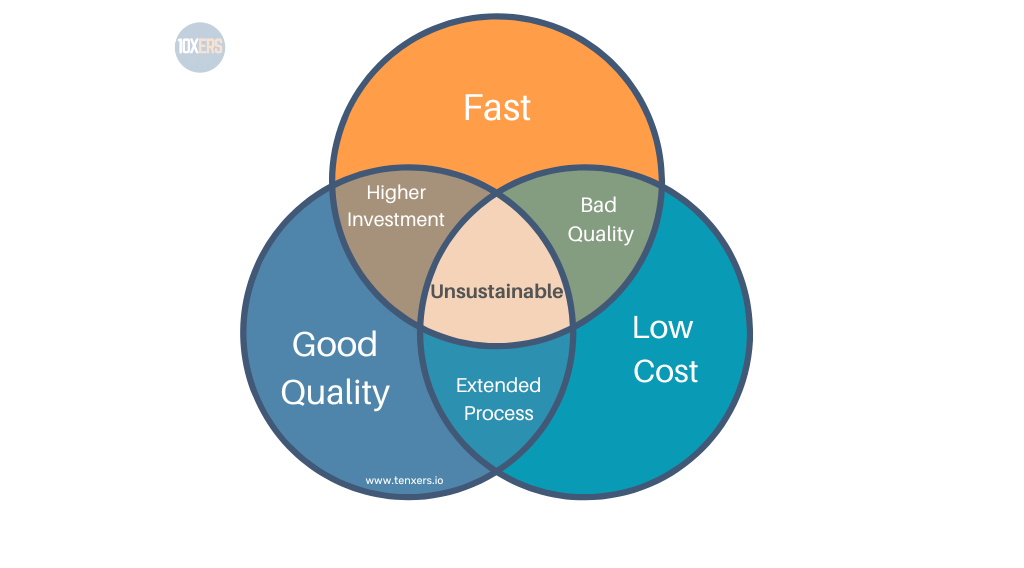JS Development Services: Buyers Guide 2024
Click on each corresponding link to jump ahead:
- How to Find an Experienced Javascript Development Team
- Terms You Will Need to Know
- Quality Assurance and Testing Process
- Best Places to Research JS Development Companies
- Hourly Rates VS. Fixed Price Projects
- How to Balance Cost and Quality with JS Development
- What Are Appropriate Response Times
- How to Determine Project Timelines
- Key Points When Choosing a JS Development Company
For more information on Javascript Development, Contact Profitworks.
1) How to Find an Experience Javascript Development Team

Source: Aimprosoft
Finding an experienced JavaScript development team is crucial for the success of your web development projects. To ensure you choose the right team, start by assessing their expertise and track record. Look for a team with a proven history of successful JavaScript projects, preferably in your industry or with similar technical requirements.
Check for the team's proficiency in popular JavaScript frameworks and libraries such as React, Angular, or Vue.js. Evaluate their understanding of front-end and back-end development, ensuring they can create seamless, responsive, and scalable applications. Additionally, consider their familiarity with version control systems like Git and their ability to collaborate effectively using agile methodologies.
Client testimonials and case studies are valuable resources to gauge a team's reliability and performance. Assess their communication skills, as clear and transparent communication is crucial for project success. Furthermore, inquire about their problem-solving approach and how they handle challenges during development.
Ultimately, a comprehensive evaluation of a JavaScript development team's technical skills, experience, and communication is essential. This thorough assessment will help you make an informed decision and collaborate with a team that aligns with your project goals and vision.
For great Javascript development services, visit Aimprosoft.
2) Terms you Will Need to Know

Source: Altexsoft
Front-end development involves creating the user interface and user experience of a website or application. It focuses on the presentation layer, encompassing HTML, CSS, and JavaScript to design and implement features that users interact with directly.
Back-end development, on the other hand, concentrates on the server side of web development. It involves managing databases, servers, and applications, ensuring the smooth functioning of the website. Server-side scripting languages like Node.js, Python, or PHP are commonly used for back-end development.
Full-stack development covers both front-end and back-end development. Full-stack developers are proficient in a broad range of technologies and can handle the entire web development process, from designing user interfaces to managing databases and server-side logic.
React, Angular and Vue.js are popular front-end JavaScript frameworks used to build interactive user interfaces. React, developed by Facebook, is known for its component-based architecture. Angular, a Google product, is a comprehensive framework offering a robust structure for building dynamic web applications. Vue.js is a progressive framework that is lightweight and easy to integrate, making it a suitable choice for smaller projects or incremental adoption in existing systems. Each framework has its strengths, and the choice depends on project requirements and developer preferences.
3) Quality Assurance and Testing Process
The quality assurance and testing process in JavaScript (JS) development is integral to ensuring the reliability and functionality of web applications. Testing in JS typically involves multiple phases, starting with unit testing. Unit tests focus on individual components, verifying that each function or module works as intended. Testing frameworks like Jest or Mocha are commonly used for this purpose.
Integration testing follows, examining how different components interact. This ensures that the integrated parts of the application function seamlessly. End-to-end testing evaluates the application's workflow from start to finish, simulating real user scenarios. Tools like Cypress or Selenium are employed for end-to-end testing, offering a comprehensive view of the application's behaviour.
Additionally, regression testing is crucial to identify and fix bugs that might arise as new features are added. Continuous integration and continuous deployment (CI/CD) pipelines are often set up to automate the testing process, ensuring that code changes are thoroughly tested before deployment.
Code analysis tools, such as ESLint, aid in maintaining code quality by identifying potential issues and enforcing coding standards. Regular code reviews by peers also contribute to identifying and rectifying potential problems early in the development process.
In summary, a robust JS quality assurance and testing process involves unit testing, integration testing, end-to-end testing, regression testing, code analysis, and continuous integration, all working together to ensure the delivery of reliable and high-quality JavaScript applications.
4) Best Places to Research JS Development Companies

Source: Clutch
When researching JavaScript development companies, it's essential to explore various platforms and resources to make informed decisions. One of the best places to start is online freelance platforms like Upwork and Freelancer, where you can find individual developers or agencies with diverse expertise in JavaScript.
Professional networking platforms such as LinkedIn offer valuable insights into a company's background, employee skills, and client reviews. GitHub is an excellent resource for assessing a company's open-source contributions, giving an indication of its coding standards and community involvement.
Review platforms like Clutch and GoodFirms provide comprehensive evaluations and client testimonials for different development companies, offering an unbiased perspective on their strengths and weaknesses. Technology forums like Stack Overflow can also be helpful in gauging a company's technical proficiency based on their participation and contributions.
Industry-specific conferences and events, both virtual and physical, allow you to interact directly with potential development partners, gaining firsthand knowledge about their skills and capabilities.
Lastly, referrals from colleagues or industry experts can be invaluable, providing trustworthy recommendations based on personal experiences. By leveraging a combination of these resources, you can thoroughly research JavaScript development companies and make well-informed choices aligned with your project requirements.
5) Hourly Rates VS. Fixed Price Projects
How To Price Your Work - Hourly or Fixed Rate? Freelance Pricing
Fixed-price development and hourly rate development each come with their own set of advantages and disadvantages.
Fixed-price development offers predictability in budgeting, making it easier for clients to plan and allocate funds. It also incentivizes developers to complete the project efficiently. However, the challenge lies in the potential lack of flexibility for changes or additions during the development process. Scope changes may lead to additional costs, and if the initial requirements are not well-defined, it can result in misunderstandings.
Hourly rate development provides more flexibility, allowing clients to make adjustments as the project progresses. Developers are paid for the actual time invested, which can be beneficial for projects with evolving requirements. However, it can be challenging for clients to estimate the overall cost, and there may be concerns about efficiency and project management, as hourly billing might incentivize developers to prolong tasks. Ultimately, the choice depends on the specific needs and dynamics of the project.
6) How to Balance Cost and Quality with JS Development

Source: Medium
Balancing cost and quality in JavaScript development involves strategic decision-making to optimize outcomes without compromising on the final product. Begin by thoroughly defining project requirements to prevent scope creep and subsequent cost increases. Prioritize features based on essential functionalities and allocate resources accordingly.
Consider leveraging open-source libraries and frameworks to reduce development time and costs without compromising quality. Implementing efficient project management methodologies, such as Agile, ensures iterative development, allowing for continuous improvement and adaptation to changing needs.
Investing in skilled developers is crucial for maintaining code quality and reducing the likelihood of errors, which could lead to increased costs in the long run. Regular code reviews, testing, and adherence to coding standards contribute to high-quality deliverables.
Furthermore, striking a balance between automated testing and manual testing helps ensure robust code without significantly inflating costs. Regular communication and collaboration between developers and stakeholders are vital for understanding priorities and making informed decisions that align with both quality and budgetary goals.
7) What Are Appropriate Response Times
Appropriate response times between developers and the company are critical for project efficiency. Timely communication ensures quick issue resolution, fosters collaboration, and maintains project momentum. Aim for responses within 24 hours for non-urgent matters and near-immediate communication for urgent issues. Establishing clear communication expectations helps streamline workflows and cultivates a productive working relationship between developers and the company.
8) How to Determine Project Timelines
How To Estimate Software Development Time
Determining a project timeline for JavaScript development involves careful planning and consideration of various factors. Start by conducting a thorough analysis of project requirements, breaking down tasks, and estimating the time needed for each. Consider the complexity of features, integration points, and potential challenges.
Additionally, accounts for testing, debugging, and potential revisions. Collaborate closely with the development team to gather their input on time estimates and potential roadblocks. Utilize project management methodologies such as Agile or Scrum to facilitate iterative development and adaptability.
Regularly review and adjust timelines based on progress and feedback. Factor in any dependencies, stakeholder reviews, and unexpected issues that may arise. Setting realistic and achievable milestones helps in creating an accurate and feasible project timeline for successful JavaScript development.
9) Key Points When Choosing a JS Development Company

Source: Chapter247
Choosing a JavaScript development company involves careful consideration of several key points to ensure a successful collaboration. First, assess the company's expertise by examining its portfolio and relevant experience in JS frameworks like React, Angular, or Vue.js. Look for client testimonials and case studies to gauge their track record.
Evaluate the team's proficiency in both front-end and back-end development, as well as their understanding of modern web development practices. Consider their approach to testing, code quality, and adherence to industry standards. Communication is vital, so ensure the company maintains transparent and effective channels for project updates and feedback.
Verify their ability to scale with your project's needs and inquire about their development methodologies. Lastly, consider factors like cost, timeline, and post-launch support. By thoroughly examining these key points, you can make an informed decision and select a JavaScript development company aligned with your project requirements and goals.
For any further questions regarding Javascript Development, Contact Us.
